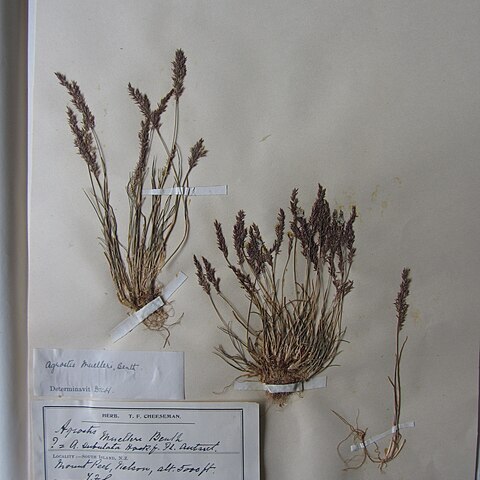Dense, often small, dull green, usually strict, perennial tufts, (3)-5-30 cm, with narrow, usually dark purplish, sometimes green spike-like panicles on slender culms much overtopping to scarcely overtopping leaves; branching intravaginal. Leaf-sheath ± membranous, light green or pale brownish, glabrous, ribs few distinct, rarely minutely scabrid above. Ligule 1-2-(3) mm, acute to truncate, usually fimbriate to lacerate, abaxially scabrid. Leaf-blade 1-7 cm × 0.4-0.7 mm diam., folded with involute margins, often filiform, or strict and firm, ± erect, sometimes more flattened and wider, to 2 mm, abaxially smooth or finely scabrid, adaxially finely scabrid on ribs; margins finely scabrid, narrowed to fine subobtuse tip; uppermost culm leaves abaxially scabrid. Culm erect, internodes glabrous. Panicle 1-4.5-(10) cm, contracted, erect, densely narrow-linear, longer panicles densely oblong, > 5 mm wide; rachis smooth or obscurely scabrid, branches and pedicels short, erect, capillary, finely scabrid. Spikelets (1.5)-2-3-(3.5) mm. Glumes ± unequal, lanceolate to ovate-lanceolate, acute to subobtuse, usually tinged deep reddish purple, occasionally entirely green, margins colourless or purplish, usually finely scabrid on keel and at times near tip, otherwise smooth or papillose; lower = spikelet, upper (1.4)-2-2.5-(3) mm. Lemma 1.4-2 mm, glabrous, 5-nerved, lateral nerves often faint, oblong-ovate, obtuse or truncate, usually minutely denticulate; awn 0, or present and dorsal, from midpoint or from just below upper ⅓, 0.5-2-(2.5) mm, delicate, usually projecting beyond glumes. Palea c. 0.4 mm, ovate. Lodicules 0.3-0.4 mm. Callus with very few minute hairs or glabrous. Anthers 0.4-1 mm. Caryopsis c. 1 × 0.3-0.5 mm.
More
Small, caespitose annual. Culms to 25 cm high, 3-noded; mid-culm internode scaberulous. Leaves mostly basal; basal sheaths glabrous or scabrous or sparsely hairy, often purple; ligule 2–3 mm long, acute or truncate, erose; blade usually flat or folded or involute, linear, 3–10 cm long, 1–5 mm wide. Panicles contracted, 1–8 cm long, usually partially or shortly exserted; primary branches alternate in groups of 1–6, appressed, with base of branch bare. Spikelets (2–) 2.2–3.5 mm long. Glumes subequal, (2–) 2.2–3.5 mm long. Lemma ovate, 1.3–2 (–3) mm long, entire or dentate, rarely awned, 5-nerved, glabrous; awn shorter than to ±equalling lemma body, to 1 mm long, arising from upper half of lemma, straight. Palea vestigial or absent. Anthers 0.5–0.8 (–1.2) mm long.

